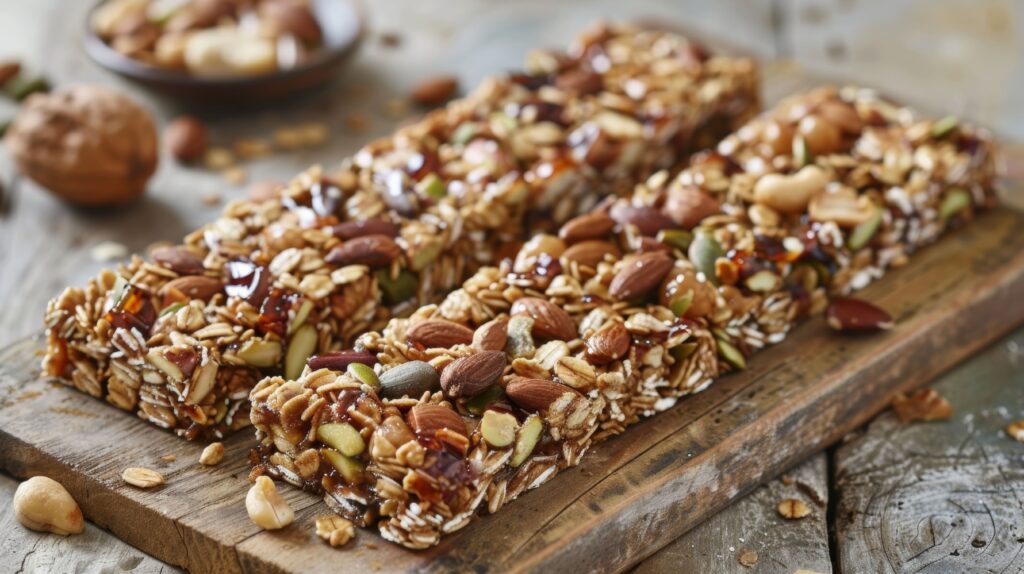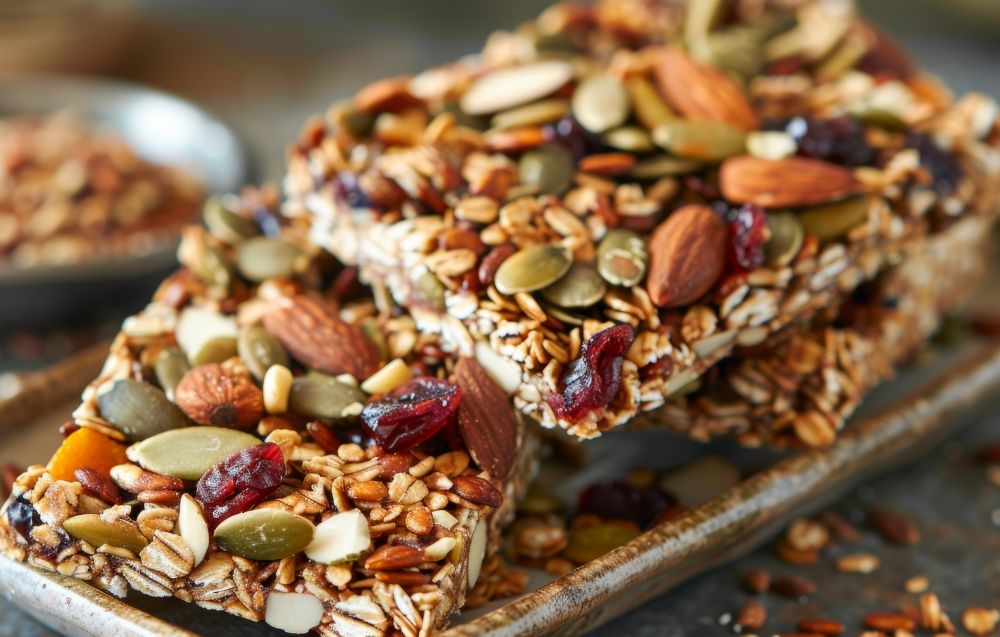Granola bars and protein bars are go-to options for quick and convenient snacking. They’re portable, easy to eat, and often marketed as healthy choices, making them popular for busy mornings, workouts, or on-the-go lifestyles. However, appearances can be deceiving—do you really know what’s inside these bars? From their ingredients to their nutritional benefits and drawbacks, there’s more to these snacks than meets the eye. Understanding their differences is key to choosing the right one for your needs, whether you’re looking for a quick energy boost or post-workout recovery. Let’s break down the details to help you decide wisely.
Introduction to Granola Bars and Protein Bars
Granola bars and protein bars might look similar at a glance, but they cater to different needs. Whether you’re after an energy boost or a post-workout recovery snack, understanding these bars can make all the difference.
What Are Granola Bars?
Granola bars are typically made from oats, nuts, dried fruits, and sweeteners like honey or sugar. They’re often marketed as an energy-boosting snack for busy mornings or on-the-go lifestyles. However, not all granola bars are created equal—some are packed with added sugars, making them closer to candy bars than health foods.
What Are Protein Bars?
Protein bars, on the other hand, are all about protein. Designed to support muscle recovery, these bars typically contain whey, soy, or plant-based protein. While they’re often marketed to fitness enthusiasts, many are also loaded with artificial ingredients, making it essential to read the label.
Check out a recipe for making easy protein granola to transform your breakfast and take control of the ingredients in your snack.
Key Differences Between Granola Bars and Protein Bars
Though granola and protein bars share some similarities, their nutritional goals differ significantly.
Ingredients Overview
Granola bars typically contain oats, dried fruits, nuts, and sweeteners, making them a great source of energy from natural ingredients. In contrast, protein bars prioritize protein-rich ingredients like whey or pea protein, designed to support muscle recovery and satiety. They often include added vitamins and fiber to enhance their nutritional value, catering to those seeking a more balanced, high-protein snack for post-workout recovery or meal replacement needs.
Nutritional Profile Comparison
Granola bars tend to be higher in carbohydrates and lower in protein, while protein bars excel in protein content but may also include more processed ingredients. Both options require careful label reading to ensure you’re making the healthiest choice.

For a fun and nutritious snack alternative, explore vegan snacks made simple, which can be tailored to suit different dietary preferences.
Nutritional Components of Granola Bars
Granola bars can be a great source of energy, but their nutritional value depends on their ingredients.
Macronutrient Breakdown: Carbs, Protein, and Fats
A typical granola bar provides:
- Carbohydrates: 20–30 grams per serving, often from oats and dried fruits.
- Protein: 2–6 grams, usually from nuts or seeds.
- Fats: 5–10 grams, depending on the type of nuts included.
While these nutrients sound balanced, added sugars can tip the scales toward being unhealthy.
Common Vitamins and Minerals Found in Granola Bars
Many granola bars contain fortified vitamins and minerals, including:
- Iron: Supports oxygen transport in the blood.
- Magnesium: Helps with muscle function.
- Vitamin B: Boosts energy production.
Added Sugars and Their Impact
One major downside of granola bars is their sugar content. Many bars contain 12–15 grams of sugar per serving, which can lead to energy spikes and crashes.
Block Quote
“Not all granola bars are as healthy as they seem—always check the label for hidden sugars.”
Nutritional Components of Protein Bars
Protein bars cater to those looking to increase their protein intake, but they come with their own challenges.
Macronutrient Breakdown: High Protein Content
Protein bars typically provide 10–20 grams of protein per serving, making them an excellent choice for post-workout recovery by aiding muscle repair and growth. They can also serve as a convenient meal replacement when you’re short on time. However, it’s important to note that many protein bars include artificial sweeteners to reduce calorie content, which can sometimes affect taste and may not suit everyone’s dietary preferences.
Fiber Content and Digestive Benefits
Fiber in protein bars, commonly sourced from ingredients like chicory root or psyllium husk, plays a crucial role in promoting healthy digestion and supporting gut health. It helps regulate bowel movements and keeps you feeling fuller for longer, making it a valuable addition for those managing weight or seeking sustained energy. However, excessive amounts of fiber—especially from artificial sources—can lead to bloating, gas, or digestive discomfort for some individuals. To avoid these issues, it’s important to check the fiber content on labels and choose bars with a moderate amount, typically 5–10 grams, that aligns with your dietary tolerance.
Artificial Sweeteners and Flavorings
Many protein bars rely on sweeteners such as sucralose or stevia to keep sugar content low while maintaining sweetness. These alternatives are popular for reducing calorie counts and appealing to those managing their sugar intake. However, not everyone enjoys the taste of artificial or natural sweeteners, as they can leave an aftertaste that some find unpleasant. Additionally, for individuals sensitive to these sweeteners, they may cause mild digestive discomfort. When choosing a protein bar, it’s worth experimenting with different brands or opting for those sweetened with natural alternatives like dates or honey for a more balanced and enjoyable flavor.
Curious about other quick and healthy breakfast ideas? Learn how to make air fryer breakfast potatoes for a savory start to your day.
Common Problems with Granola and Protein Bars
Let’s face it: not all granola and protein bars live up to their healthy reputation. Some are loaded with unnecessary ingredients that can negate their benefits. Let’s tackle the most common issues and how to address them.
High Sugar Content in Granola Bars
Granola bars are often marketed as health foods, but many are closer to candy bars in disguise. A single bar can contain 12–15 grams of added sugar. This can lead to energy spikes and crashes, as well as contribute to weight gain if consumed excessively.
If you’re looking for a healthier option, focus on reading food labels. How to read food labels effectively is an essential skill for spotting hidden sugars and identifying better choices.
Over-Processing and Additives in Protein Bars
Protein bars often contain artificial ingredients to enhance taste, texture, and shelf life. These can include:
- Artificial sweeteners like sucralose or aspartame.
- Synthetic fibers that may cause digestive discomfort.
- Processed protein isolates that lack the nutritional depth of whole foods.
Want to understand these additives better? Check out this guide on Common artificial sweeteners and their effects to make more informed decisions.
Misleading Nutrition Labels and Claims
It’s easy to be swayed by labels claiming “low fat,” “sugar-free,” or “packed with protein.” However, these claims can be misleading. For instance, “sugar-free” bars often replace sugar with artificial sweeteners, and “low fat” doesn’t always mean low calorie.
Knowing how to interpret a label is crucial. Dive into Understanding macronutrients for a balanced diet for insights into what those numbers really mean.
Solutions for Choosing Healthy Options
The good news is that you don’t have to give up on granola and protein bars entirely. By being mindful, you can find options that align with your nutritional goals.
Tips for Reading and Understanding Nutrition Labels
Start by focusing on these key components:
- Serving size: Check if the numbers are for the whole bar or just a portion.
- Added sugars: Look for bars with less than 8 grams of sugar.
- Protein content: Aim for 10–20 grams for protein bars and 5–7 grams for granola bars.
Ingredients to Look for and Avoid
Look for:
- Whole grains like oats.
- Natural sweeteners like honey or maple syrup.
- Real nuts, seeds, and dried fruits.
Avoid:
- Artificial flavors and sweeteners.
- High fructose corn syrup.
- Hydrogenated oils.
DIY Homemade Granola and Protein Bars
Sometimes, the best way to control your nutrition is to make your own snacks. Homemade bars allow you to choose whole, unprocessed ingredients while avoiding additives and excessive sugars.
Benefits of Including Granola Bars and Protein Bars in Your Diet
Despite the challenges, granola and protein bars can be beneficial when chosen wisely.
On-the-Go Convenience
For busy mornings or lengthy commutes, granola and protein bars are a true lifesaver. Their portability, long shelf life, and quick consumption make them an ideal choice for anyone juggling a hectic schedule. Whether you’re rushing out the door or stuck in traffic, these bars offer a convenient way to stay energized and satisfied without missing a beat.
Energy Boost for Physical Activities
Granola bars excel at providing sustained energy, making them perfect for fueling hikes, long workdays, or any activity requiring endurance. In contrast, protein bars are tailored for post-workout recovery, offering the nutrients needed to repair and rebuild muscles after physical exertion.
Supporting Weight Management Goals
Both granola and protein bars can play a role in a healthy diet when eaten in moderation. Their portion-controlled servings help curb overeating, making them a practical option for snacks or meal replacements. Granola bars are ideal for energy boosts, while protein bars support muscle recovery and satiety. However, it’s essential to keep an eye on their calorie content, as some bars can be surprisingly high in sugars and fats. This is particularly important if weight management is your goal. By choosing bars with balanced nutrition and minimal added sugars, you can enjoy them as part of a mindful diet.
When to Choose a Granola Bar vs. a Protein Bar
Granola bars and protein bars serve different purposes, so knowing when to choose each can make all the difference in meeting your nutrition goals. Let’s break it down by scenarios.
Best Scenarios for Granola Bars
Granola bars are ideal for situations where you need a quick energy boost. They’re often rich in carbohydrates, which are your body’s primary fuel source. Here are a few examples:
- Mid-Morning Snack:
If breakfast feels like a distant memory and lunch is hours away, a granola bar can help bridge the gap. It’s a quick, light option to keep your energy up without spoiling your next meal. - Before a Workout:
The carbs in granola bars provide the fuel your body needs for physical activity. Grab one 30–60 minutes before hitting the gym, and you’ll have the energy to power through your routine. - Outdoor Adventures:
Heading out for a hike or a long day in the great outdoors? Granola bars are easy to pack and provide sustained energy, thanks to their combination of oats, nuts, and dried fruits.
Ideal Situations for Protein Bars
Protein bars shine when you need to focus on recovery or satiety. With their high protein content, they’re perfect for:
- Post-Workout Recovery:
After a strenuous workout, your muscles are primed for repair and growth. Protein bars provide the amino acids necessary for recovery, making them an excellent post-exercise snack. - Meal Replacement:
In a pinch, a protein bar can serve as a substitute for a meal. While it’s not ideal to replace meals regularly, it’s better than skipping one altogether. Look for bars with at least 200–300 calories and a balance of protein, carbs, and healthy fats. - Travel Days:
Long flights or road trips often leave you with limited food options. Protein bars are a practical choice to keep you full and satisfied until you can enjoy a proper meal.
The Pros and Cons of Granola Bars and Protein Bars
No food is perfect, and granola and protein bars are no exception. Let’s weigh their pros and cons to help you make smarter choices.
Granola Bar Pros
- Convenience: Easy to carry and eat anywhere.
- Natural Ingredients: Many brands focus on whole grains, nuts, and fruits.
- Energy Boost: Perfect for quick energy during busy days or physical activity.
Granola Bar Cons
- High in Sugar: Many bars contain added sugars that diminish their health benefits.
- Low Protein: Not ideal if you’re looking to build or repair muscle.
- Misleading Marketing: Labels like “organic” or “all-natural” can disguise unhealthy ingredients.
Protein Bar Pros
- High Protein Content: Excellent for recovery and keeping you full longer.
- Versatility: Can double as a meal replacement in a pinch.
- Customizable Options: Many brands cater to dietary needs like gluten-free or keto.
Protein Bar Cons
- Over-Processing: Many contain artificial sweeteners, preservatives, and fillers.
- Cost: Often more expensive than granola bars.
- Taste and Texture: Some bars have a chalky or overly sweet taste.
Block Quote:
“Neither bar is inherently better; it’s about finding the right option for your unique needs.”
Tips for Making Smarter Choices
Navigating the world of granola and protein bars can be overwhelming, but with these tips, you’ll be a pro in no time.
Check the Ingredients List
Always look at the first few ingredients listed—they make up the bulk of the product. For granola bars, whole grains like oats should take the top spot. For protein bars, aim for real protein sources like whey, pea, or soy isolate.
Aim for Balance
A good granola or protein bar should provide a mix of macronutrients:
- Protein: At least 10 grams for a protein bar, 5 grams for a granola bar.
- Carbs: Preferably from whole grains or natural sugars like honey.
- Fats: Healthy fats from nuts, seeds, or coconut oil.
Be Wary of Added Sugars
Avoid bars with ingredients like high fructose corn syrup or cane sugar high on the list. Instead, opt for bars sweetened with dates, honey, or minimal amounts of natural sugar.
DIY Options: Homemade Granola and Protein Bars
Making your own granola or protein bars is easier than you think and allows you full control over the ingredients. Here’s how you can get started:
Simple Homemade Granola Bars
Ingredients:
- 2 cups of rolled oats
- 1/4 cup of honey or maple syrup
- 1/2 cup of chopped nuts (e.g., almonds or pecans)
- 1/4 cup of dried fruits (e.g., raisins or cranberries)
- 2 tablespoons of coconut oil
Instructions:
- Preheat your oven to 350°F (175°C).
- Mix all ingredients in a bowl until well combined.
- Press the mixture into a parchment-lined baking dish.
- Bake for 20–25 minutes or until golden brown.
- Let cool before cutting into bars.
Simple Homemade Protein Bars
Ingredients:
- 1 cup of protein powder (e.g., whey or plant-based)
- 1/2 cup of almond butter
- 1/4 cup of honey
- 1/4 cup of oats or almond flour
Instructions:
- Combine all ingredients in a bowl.
- Press the mixture into a lined dish and refrigerate for 1–2 hours.
- Cut into bars and store in an airtight container.
Conclusion: Making Informed Choices for Better Nutrition
Granola bars and protein bars each serve unique purposes in a balanced diet. Granola bars provide quick energy, making them ideal for busy mornings or outdoor activities, while protein bars focus on muscle recovery and satiety, perfect for post-workout snacks or meal replacements. By understanding their nutritional profiles, such as carbs in granola bars and protein in protein bars, you can choose the right option for your goals. Recognizing common pitfalls, like high sugar content or artificial ingredients, and learning to read labels effectively will help you make informed decisions. With mindful choices, these bars can fuel your lifestyle.
Remember, the key is to be mindful—whether you’re reading a label at the store or crafting your own bars at home. Armed with this knowledge, you’re ready to snack smarter and fuel your body more effectively.

